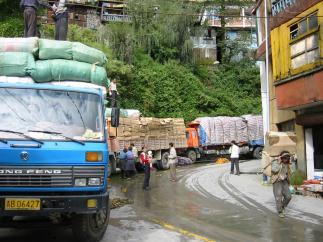Difference between revisions of "Rural-Urban-Linkages"
***** (***** | *****) |
***** (***** | *****) |
||
| Line 26: | Line 26: | ||
|} | |} | ||
| + | |||
= Endangering the Food Supply = | = Endangering the Food Supply = | ||
| + | |||
| + | Urbanisation also creates new challenges in connection with the transport of goods. As a result of the spread of cities and rapid population growth, the area of farmland available per person on the planet fell by 50 per cent between 1961 and 2005 (UN 2012). The consequence of less farmland being available, along with the growth and concentration of the population and the rise in the demand for food per person that is being seen everywhere, is that an ever more efficient transport infrastructure is needed to transport goods over ever greater distances in order to maintain the food supply. <br/>The population of Dhaka, the capital of Bangladesh, is increasing at a rate of about 500,000 people per year, and the demand for rice alone is rising by about 80,000 tonnes per year. To supply the city’s new inhabitants with rice, an additional 4,000 lorry-loads of rice per year must be brought in from the rice-growing districts, most of which are several hundred kilometres away, putting additional pressure on the transport infrastructure. <br/> | ||
| + | |||
= Importing Food pushes up Food Prices = | = Importing Food pushes up Food Prices = | ||
Revision as of 15:54, 15 September 2013
Overview
Since 2009, for the first time in history there have been more people living in urban areas than in rural ones. The United Nations calculates that by 2050 about 70 per cent of the world’s population will be living in cities. Urbanisation is increasing particularly quickly in newly industrialising and developing countries, with far-reaching consequences for the reciprocal relationships between rural and urban areas.
The following articles explains........
The Pulling Power of the Cities
There is a steady growth in the exchange of information, capital, values, work, education and medical care between rural and urban areas. Many people spend several hours a day travelling to and from their place of work or education in the city. Some regularly spend several weeks or months in what are often better-paid jobs in the city. This need for mobility, which is often the result of economic forces, increases the demand for transport links between city and countryside.
Investment in Rural Areas by Migrants
People who leave rural areas in order to earn money in the cities often invest at least some of their earnings in their home region – either by sending remittances or by transferring means of production (machinery and equipment) or consumer goods (such as electrical goods and household appliances). These investments are often the only way in which the rural area profits from innovation.
|
Secondary centres often function as transhipment points for products from rural regions.[1] |
Endangering the Food Supply
Urbanisation also creates new challenges in connection with the transport of goods. As a result of the spread of cities and rapid population growth, the area of farmland available per person on the planet fell by 50 per cent between 1961 and 2005 (UN 2012). The consequence of less farmland being available, along with the growth and concentration of the population and the rise in the demand for food per person that is being seen everywhere, is that an ever more efficient transport infrastructure is needed to transport goods over ever greater distances in order to maintain the food supply.
The population of Dhaka, the capital of Bangladesh, is increasing at a rate of about 500,000 people per year, and the demand for rice alone is rising by about 80,000 tonnes per year. To supply the city’s new inhabitants with rice, an additional 4,000 lorry-loads of rice per year must be brought in from the rice-growing districts, most of which are several hundred kilometres away, putting additional pressure on the transport infrastructure.
Importing Food pushes up Food Prices
Strengthening Regional Structures by Improving Urban-Rural Linkages
Further Information
References
- ↑ Photo: Gerhard Metschies, Tibet, China, 2002.




















